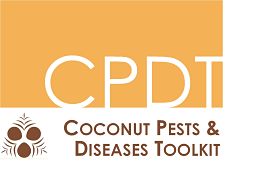Practical prevention
For all pests and diseases, simple and basic biosecurity actions can save a lot of time, effort and money. Most importantly, the International Guidelines for transfer of coconut germplasm should be strictly followed to prevent pests and diseases being moved to new locations (whether this is internationally, regionally or locally).
In this sub-section: Movement and transportation : Surveillance and awareness : Information sources and further reading
Movement and transportation
- Never move palms or seeds or germplasm from infested / infected areas (See guidelines on transporting coconut genetic resources).
- The transport of live coconut tissue without regulation will increase the chances of spread especially since it is unknown if the disease is spread through pollen or seed nuts.
- Coconut can be a host to diseases of other plants (e.g. pineapple mealybug) and vice versa - take precautions when moving any plant materials. Seek the advice of your Agriculture department or SPC for information on other plants that host pests and diseases of coconut. Other palm species are common alternative hosts.
- Diseases can be transported in all live plant tissues (seeds, nuts and pollen). The only way to ensure they are not spread is to ban their import or domestic movement.
- Cargoes and shipping can hide many small insects and ants and should always be subject to biosecurity actions, particularly when carriers have traveled from or through an infested area. Pay close attention to:
- shipping containers.
- agricultural equipment.
- forestry products.
- compost and soils.
- plants and planting materials.
Surveillance and awareness
- Surveillance is important. You might be living in an area that is free of major pests and diseases. It is very easy not to worry about something that you are not aware of.
- Encourage local biosecurity teams to undertake regular surveillance for pests and diseases that are a key rick (e.g. present in trading partner countries; high risk species).
- Encourage awareness of key risks (e.g. coconut rhinoceros beetle) by staff in transport areas including importers, airport and port staff, customs staff.
- Knowing which pests and diseases are present in trading partner countries helps identify risks. We have collated a distribution database of pests and diseases of coconut (derived from information on the CABI Invasive Species Compendium).
Information sources and further reading
You can find a comprehensive guide to prevention in the Pacific Invasive Ant Toolkit (PIAT). Although the PIAT focuses on ants, the general principles (Pre-export and Pre-, At-, and Post-border protection) are the same for all pest and disease threats.
COGENT. 2018. Darwin Initiative "Upgrading and broadening the new South-Pacific International Coconut Genebank". [ONLINE]
EPPO. 2018. EPPO Global Database. [ONLINE]
Faleiro et al. 2016. Integrated Pest Management (IPM) of Palm Pests. Integrated Pest Management in the Tropics, pp. 439-497
FAO. 2018. Adopted Standards (ISPMs). [ONLINE]
Frison, Putter, Diekmann. 1993. FAO/IBPGR Technical Guidelines for the Safe Movement of Coconut Germplasm. FAO and IBPGR, p.1-48.
PIAT. 2018. The Pacific Invasive Ant Toolkit: preventing ant problems. [ONLINE]
World Trade Organisation. 1998. Agreement on the Application of Sanitary and Phytosanitary Measures ("SPS Agreement"). [ONLINE]
